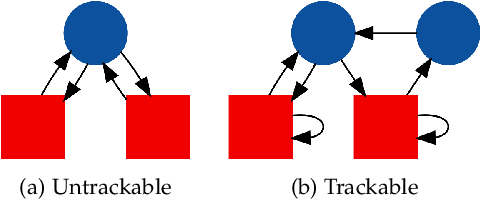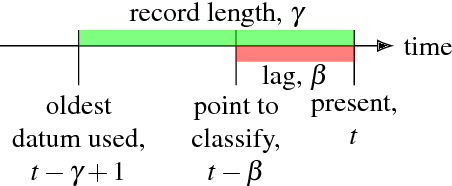Isaac Dekine
Analytic Properties of Trackable Weak Models
Jan 08, 2020



Abstract:We present several new results on the feasibility of inferring the hidden states in strongly-connected trackable weak models. Here, a weak model is a directed graph in which each node is assigned a set of colors which may be emitted when that node is visited. A hypothesis is a node sequence which is consistent with a given color sequence. A weak model is said to be trackable if the worst case number of such hypotheses grows as a polynomial in the sequence length. We show that the number of hypotheses in strongly-connected trackable models is bounded by a constant and give an expression for this constant. We also consider the problem of reconstructing which branch was taken at a node with same-colored out-neighbors, and show that it is always eventually possible to identify which branch was taken if the model is strongly connected and trackable. We illustrate these properties by assigning transition probabilities and employing standard tools for analyzing Markov chains. In addition, we present new results for the entropy rates of weak models according to whether they are trackable or not. These theorems indicate that the combination of trackability and strong connectivity dramatically simplifies the task of reconstructing which nodes were visited. This work has implications for any problem which can be described in terms of an agent traversing a colored graph, such as the reconstruction of hidden states in a hidden Markov model (HMM).
Observability Properties of Colored Graphs
Nov 09, 2018



Abstract:A colored graph is a directed graph in which either nodes or edges have been assigned colors that are not necessarily unique. Observability problems in such graphs are concerned with whether an agent observing the colors of edges or nodes traversed on a path in the graph can determine which node they are at currently or which nodes they have visited earlier in the path traversal. Previous research efforts have identified several different notions of observability as well as the associated properties of colored graphs for which those types of observability properties hold. This paper unifies the prior work into a common framework with several new analytic results about relationships between those notions and associated graph properties. The new framework provides an intuitive way to reason about the attainable path reconstruction accuracy as a function of lag and time spent observing, and identifies simple modifications that improve the observability properties of a given graph. This intuition is borne out in a series of numerical experiments. This work has implications for problems that can be described in terms of an agent traversing a colored graph, including the reconstruction of hidden states in a hidden Markov model (HMM).
 Add to Chrome
Add to Chrome Add to Firefox
Add to Firefox Add to Edge
Add to Edge